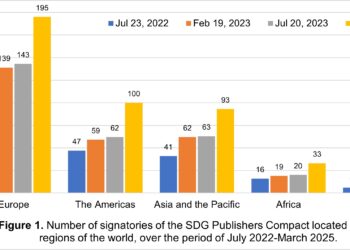
- Image by MSVG via Flickr
Selected Post: Why Hasn’t Scientific Publishing Been Disrupted Yet?
Often I’ve found that the work that is both the most rewarding personally, and that most engages with others, stems from asking questions about current topics which I don’t completely understand: Why should anyone in scholarly publishing care about Twitter? Why do trade publishers talk so much about the “supply chain” whereas that term is totally foreign to STM publishers? Everyone is talking about scientific publishing being disrupted by market forces and various innovators, so why hasn’t that happened?
This last question provoked my most lengthy, most read, and most commented-on Scholarly Kitchen post to-date. The post stemmed from a genuine lack of understanding as to why this industry would remain relatively stable, despite the fact that the Internet and the World Wide Web were both created with the explicit intention of transforming scientific communication. The tsunami wave unleashed by these twin inventions has swept entire industries away and remade the global information landscape practically overnight. And yet the STM and scholarly publishing corner of the world seemed to move with relative ease and an in an orderly fashion to an online orientation. In fact, one post in response wondered if it’s truly disruption when you’ve done it to yourself.
This post explores some reasons why this might be the case. The conversation in the comments section is definitely a worth a read as is Kent Anderson’s related post on the Age of Systems.
Discussion
5 Thoughts on "Michael's Pick for 2010: The Disruption (or Not) of Scientific Publishing"
First, a couple of niggling historical points. The Internet was not created to transform scientific communication. It was created by the military as a prototype communication system that could withstand a nuclear attack. Universities were just the test-bed. Second it was not overnight, it was 40 years ago.
That said let me point out that the Internet and the Web have transformed scientific publishing. We don’t send typescripts to journals, reviewers, authors, etc. Nor do I track down and read paper journals in libraries. I quickly find and read articles in journals I have never heard of. Having found one article I quickly find others, by other authors and in different journals, using more-like-this search. Or I go to an author’s pub page and read his or her other stuff. I discuss important articles in real time with people around the world.
How is this not a transformation? “Disruption” on the other hand is a metaphor. Is this a business term? What does it mean, such that important new technologies must do it? Economic impact?
In the case of the transformations listed above it is mostly the mail, highway, auto and phone systems that have been disrupted. I now scholarly communicate 100 times more than I used to but I no longer have to travel, copy, mail or use the phone to do it. This is a huge change for me, but scholarly publishing is so small that the highway, mail and phone systems have not been disrupted by it.
This is a physical communication revolution, not a thought revolution, so thought has stayed pretty much where it was. Scholarly publishing is mostly about creating thought in a usable form. That part has not changed much, so the disruption is simply not that great.
David – The reference to the Internet above is a typo. If you read my post on disruption I make no claims for the Internet itself being created to disrupt scientific and scholarly communication – only the Web. That being said, I would posit a distinction between ARPNET (which was created by DARPA et al. for the purposes you describe) and the Internet, which followed.
I’m using disruption in a very specific way, describing the phenomena described by Clay Christensen in his seminal book, the Innovators Dilemma. It is a description of a business cycle in which successful, innovative, and well-run companies are unable to defend against new competitors due to fundamental changes in technology or market dynamics. Intel’s Andy Grove would later describe something very similar, using the term “infection points,” in his book Only the Paranoid Survive.
Electronic journals may be, well, electronic, but they are just the same thing faster (a great benefit but not really a fundamental rethinking of the format). Most of the same organizations involved in scholarly publishing in 1990 are still around and going strong in 2010. There was talk in the mid-1990s of the journal being replaced by ArXive-like databases but, outside of ArXive (which has recently had financial difficulties), it never happened. Open access journals function just like subscription journals – they just charge authors instead of readers.
The other key point in my post was that it was, in large part, a response to many in the scholarly publishing community who, unlike yourself, think scholarly publishing was – and remains – on the verge of a disruptive wave that will change the face of the industry in short order. My point was there are some specific reasons having to with how scholarly publishing function in the community it serves, that make such a disruption unlikely.
Hasn’t the Internet in fact disrupted STM journal publishing by making the concept of the journal issue increasingly anachronistic? There is really no need for collecting heterogeneous sets of articles into issues anymore in the digital environment, and the fact that most publishers continue to do so seems more a matter of habit than anything else. As for the journal itself, its main function in the digital age is as a branding mechanism, rather than a container of content, isn’t it?
I agree that there is no purpose to a journal issue – and indeed the industry is slowly moving to a continuous publication model. And I also agree that journals are largely filters for readers and marketing platforms for authors. That being said, the migration to continuous publishing doesn’t really upset any apple carts. The same journals that use issues can simply abandon issues. And journals have always always served this filtering/marketing function so no big change there.
What kind of disruption were you thinking might occur? Scholarly publishing is driven by well-entrenched professional practices and standards in higher education (viz., the entire apparatus of the tenure and promotion system), and until this system changes, there is little reason to expect any major change in publishing either. Technology serves scholarship, not the other way around.



